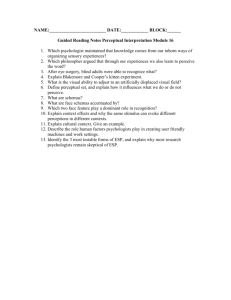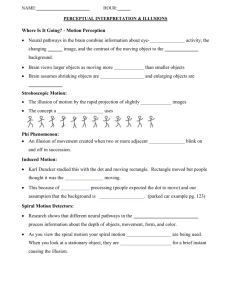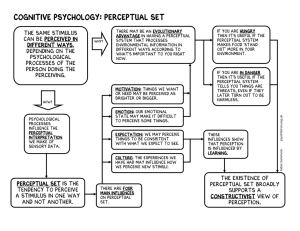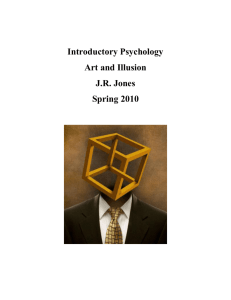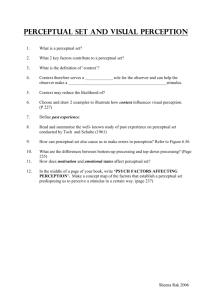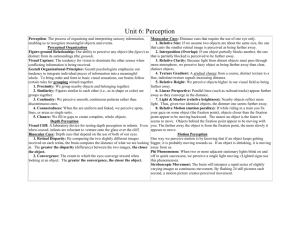Perception Unit Test - Psychology Questions
advertisement
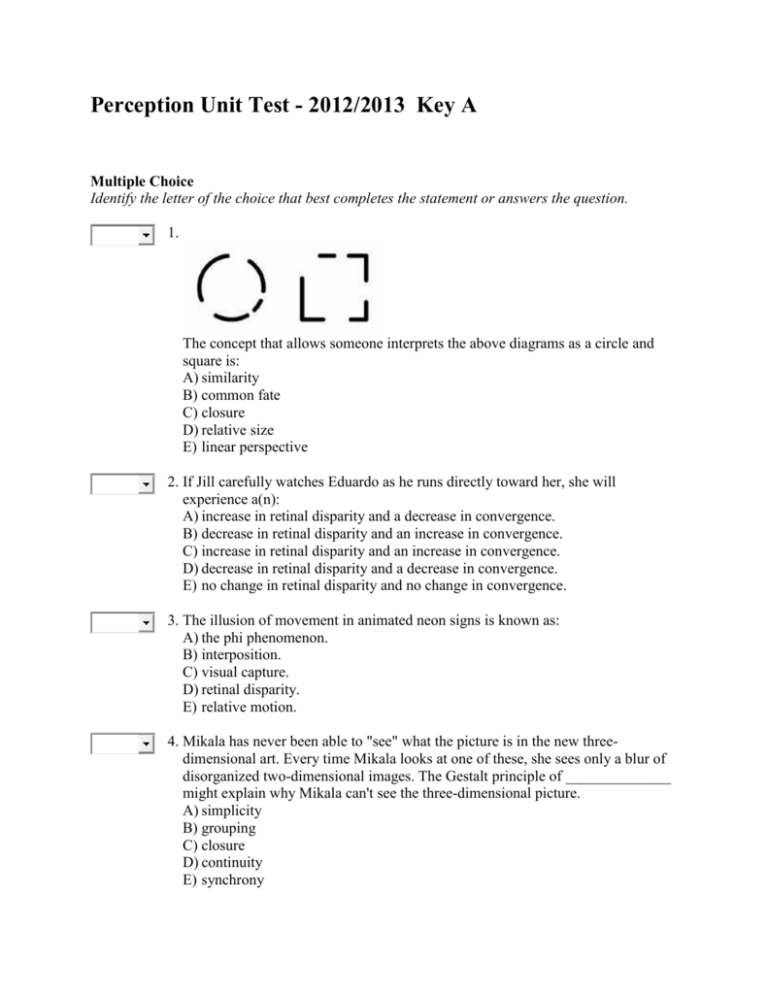
Perception Unit Test - 2012/2013 Key A Multiple Choice Identify the letter of the choice that best completes the statement or answers the question. 1. The concept that allows someone interprets the above diagrams as a circle and square is: A) similarity B) common fate C) closure D) relative size E) linear perspective 2. If Jill carefully watches Eduardo as he runs directly toward her, she will experience a(n): A) increase in retinal disparity and a decrease in convergence. B) decrease in retinal disparity and an increase in convergence. C) increase in retinal disparity and an increase in convergence. D) decrease in retinal disparity and a decrease in convergence. E) no change in retinal disparity and no change in convergence. 3. The illusion of movement in animated neon signs is known as: A) the phi phenomenon. B) interposition. C) visual capture. D) retinal disparity. E) relative motion. 4. Mikala has never been able to "see" what the picture is in the new threedimensional art. Every time Mikala looks at one of these, she sees only a blur of disorganized two-dimensional images. The Gestalt principle of ______________ might explain why Mikala can't see the three-dimensional picture. A) simplicity B) grouping C) closure D) continuity E) synchrony 5. Sascha is in a marching band. Because the band members move together identically, the audience perceives waves of motion. Sascha's band director has used the Gestalt principle of ______________ to cause the audience to perceive the waves of motion. A) simplicity B) closure C) texture D) proximity E) common fate 6. In perceiving depth and distance, we interpret the pattern of light and shadow, and we normally assume that illumination comes from A) side. B) the left side. C) above. D) behind. E) below. 7. If two objects cast retinal images of the same size, the object that appears to be closer is perceived as ________ the object that appears to be more distant. A) smaller than B) overlapping C) the same size as D) clearer than E) larger than 8. Janice experienced motion sickness simply from watching a movie scene of a thrilling motorcycle chase. Her experience best illustrates the impact of: A) visual capture. B) location constancy. C) perceptual adaptation. D) retinal disparity. E) relative motion. 9. At the kennel, Jim can tell that the terrier is closer to him than the collie because his eyes have to turn inward more to focus the terrier's image on his retina. This feedback tells him that the terrier is closer. This is an example of A) interposition. B) motion parallax. C) binocular disparity. D) convergence. E) accommodation. 10. Although several students in the classroom are talking loudly, Jim's attention is focused only on what his girlfriend is saying. In this instance, the girlfriend's voice is a: A) perceptual set. B) gestalt. C) convergence. D) perceptual adaptation. E) figure. 11. Lightness constancy refers to the fact that: A) objects are perceived to have consistent lightness even if the amount of light they reflect changes. B) the perceived whiteness of an object has a constant relation to its lightness. C) lightwaves always have the same wavelength and wave amplitude. D) the frequency of light waves has a fixed relationship to the brightness of the light. E) light waves reflected by an object remain constant despite changes in illumination levels. 12. Stereotypes are mental conceptions that can strongly influence the way we interpret the behaviors of individuals belonging to specific racial or ethnic groups. A stereotype is most similar to a: A) feature detector. B) perceptual set. C) texture gradient. D) stereogram. E) perceptual adaptation. 13. When Jason briefly turned to summon the waiter, his wife quickly switched her glass of red wine with his glass of white wine. Jason's failure to notice that his chosen wine had been replaced best illustrates: A) interposition. B) change blindness. C) selective attention. D) the Ponzo illusion. E) visual capture. 14. The visual cliff is a laboratory device for testing ________ in infants. A) size constancy B) depth perception C) figure-ground perception D) selective attention E) perceptual adaptation 15. The above diagram is an example of: A) impossible figure B) Ponzo illusion C) Mueller-Lyer illusion D) figure-ground illusion E) Zollner illusion 16. At the hockey game, Marcos could easily spot who was cheering for the other team. They were seated throughout the arena, but each of them was wearing their team colors of red and gray. Marcos was relying on the grouping principle of A) similarity. B) proximity. C) connectedness. D) closure. E) common region. 17. Claire worked all night on a 500-piece jigsaw puzzle but misplaced ten of the puzzle's pieces. She showed the puzzle to her friend Karen. Even though the puzzle was missing ten pieces, Karen could still perceive a complete picture by using the perceptual process of A) proximity. B) similarity. C) continuity. D) texture. E) closure. 18. A brochure displays a long stretch of road. The lines that make up the road are drawn so that they converge at the horizon. The result is that the picture creates a sense of distance. This is based on an environmental depth cue called A) relative size. B) linear perspective. C) texture gradient. D) convergence. E) closure. 19. The above diagram is an example of: A) impossible figure B) Mueller-Lyer illusion C) Ponzo illusion D) figure-ground illusion E) Zollner illusion 20. Experiments with the visual cliff suggest that: A) an infant’s cones are not fully developed. B) unlike other animals, humans do not perceive depth until about 8 months of age. C) the ability to perceive depth is at least partially innate. D) humans must learn to recognize depth. E) binocular cues are more important than monocular cues. 21. If two identical objects are equally distant from a viewer, the brighter object appears to be: A) larger. B) more finely textured. C) less colorful. D) less detailed. E) closer. 22. The Müller-Lyer illusion involves the misperception of: A) relative clarity. B) binocular distance cues. C) figure-ground relationships. D) a visual cliff. E) the length of lines. 23. We compute motion based on the assumption that shrinking objects are: A) conducting. B) fixation points. C) schemas. D) binocular cues. E) retreating. 24. In order to make the Where's Waldo pictures challenging, the creator, Martin Hanford, must make sure that all the people in the picture are closer together, thus making it more difficult to pick out Waldo from the background. In this way, Martin is playing with the grouping principle of A) closure. B) synchrony. C) connectivness. D) common region. E) proximity. 25. The grouping principle of connectedness is best exemplified by A) three people standing close to each other. B) a group of volunteers all wearing the same T-shirt. C) a row of protesters holding hands to create a barrier. D) a loading zone area painted completely in yellow. E) a continuous line drawn on a map. 26. Felix was so preoccupied with his girlfriend's good looks that he failed to perceive any of her less admirable characteristics. This best illustrates the dangers of: A) perceptual adaptation. B) perceptual constancy. C) figure-ground relationships. D) the cocktail party effect. E) selective attention. 27. Perceiving objects as having consistent shape, size, and color regardless of the angle, distance, and lighting conditions from which we view them is known as: A) selective attention. B) perceptual set. C) inattentional blindness. D) change blindness. E) perceptual constancy. 28. Parapsychology refers to the: A) direct transmission of thoughts from one mind to another. B) study of the phi phenomenon. C) ability to perceive future events. D) study of phenomena such as ESP and psychokinesis. E) study of perceptual illusions. 29. Schemas are best described as: A) networks of interconnected brain cells. B) concepts that organize sensory input. C) visual receptor cells located in the eye. D) monocular cues for depth perception. E) combinations of inputs from the various senses. 30. When little Rosario quickly flipped the pages of her new "flip" book, Sniffy the rat appeared to run around, eat cheese, and scratch himself. Rosario's perception of Sniffy's movements is due to A) the Gestalt principle. B) looming. C) motion parallax. D) optical flow. E) stroboscopic motion. 31. Jamal claims that his special psychic powers enable him to perceive exactly where the body of a recent murder victim is secretly buried. Jamal is claiming to possess the power of: A) psychokinesis. B) telepathy. C) clairvoyance. D) precognition. E) parapsychology. 32. Retinal disparity refers to the: A) tendency to see stimuli that are near each other as parts of a unified object. B) tendency to see parallel lines as coming together in the distance. C) somewhat different images our two eyes receive of the same object. D) extent to which our eyes turn toward each other when looking at an object. E) retinal images being sent to each hemisphere of the brain. 33. Cars are typically perceived as ________ if they have bright rather than dim headlights. Cars are typically perceived as ________ if they are higher rather than lower in our field of vision. A) closer; farther away B) farther away; farther away C) closer; closer D) farther away; closer 34. Telepathy, clairvoyance, and precognition are different forms of: A) extrasensory perception. B) psychokinesis. C) the Ponzo illusion. D) the phi phenomenon. E) convergence. 35. Which of the following distance cues most likely contributes to the perception that the height of the St. Louis Gateway Arch is greater than its width? A) linear perspective B) convergence C) hue D) relative height E) interposition 36. Thousands of controlled experiments indicate that: A) there is no reliable evidence that anyone possesses ESP. B) ESP exists only in a few specially gifted people. C) it is impossible to conduct scientifically valid tests of ESP. D) ESP exists beyond the capability of our instruments to detect. E) many people have ESP. 37. You know that your friends Manuel and William are the same height. You use the fact that Manuel's image on your retina is smaller than William's to conclude that Manuel must be farther away from you. Which depth cue are you using? A) Interposition B) Height in the visual field C) Relative size D) Textural gradient E) Similarity 38. A perceptual set is a: A) mental predisposition that influences what we perceive. B) tendency to view similar elements as part of a single group. C) combination of hue, brightness and clarity. D) readiness to perceive an object in an unfairly negative fashion. E) tendency to fill in gaps so as to perceive a complete, whole object. 39. Gestalt psychologists emphasized that: A) perception is independent of sensation. B) we learn to perceive the world through experience. C) depth perception is only due to monocular cues. D) the whole is equal to the sum of its parts. E) we organize sensations into meaningful patterns. 40. The above diagram is an example of: A) figure-ground illusion B) Ponzo illusion C) Zollner illusion D) Mueller-Lyer illusion E) impossible figure 41. While waiting at the end of a long line, Roger notices that he can't determine the hair color or facial features of the people at the front of the line, but he can do so with people near him. Roger would perceive people at the front of the line to be farther away due to what depth perception cue? A) Linear perspective B) Interposition C) Binocular disparity D) Texture gradient E) Convergence 42. When Helen noticed that her classmates were all wearing expensive designer jeans, she suddenly perceived her own off brand jeans to be very unattractive. This best illustrates the importance of: A) perceptual adaptation. B) visual capture. C) context effects. D) texture gradient. E) convergence. 43. Who would be most involved in designing user-friendly programming controls for TVs, VCRs, and DVD players? A) Gestalt psychologists B) behavioral psychologists. C) parapsychologists D) human factors psychologists E) evolutionary psychologists 44. When Monet paints haystacks, he depicts the haystacks that are closer to him with a lot of detail but the ones farther away with less detail. He also paints a barn that is in the distance as partially blocked by one of the haystacks. Monet is using the depth cue of ______ to depict the haystacks and ______ to depict the position of the barn. A) relative size; texture gradient B) linear perspective; interposition C) interposition; height in the visual field D) texture gradient; relative size E) texture gradient; interposition 45. Rudy claims that his special psychic powers enable him to correctly anticipate whether the outcome of a coin toss will be heads or tails. Rudy is claiming to possess the power of: A) conduction. B) clairvoyance. C) psychokinesis. D) telepathy. E) precognition. 46. The Moon just above the horizon typically appears to be unusually: A) large because we perceive it as unusually close to ourselves. B) large because we perceive it as unusually far away from ourselves. C) bright because we perceive it as unusually close to ourselves. D) colorful because we perceive it as unusually far away from ourselves. E) bright because we perceive it as unusually far away from ourselves. 47. At a hockey game, Aneesha notices three people sitting next to each other, all wearing the same team jerseys, and who all jump up and cheer at the same time. When the game ends, Aneesha notices that these three people all walk toward the south entrance, moving at about the same speed. In this example, which perceptual cue did not contribute to Aneesha's perception of these three people as a group? A) similarity B) proximity C) common fate D) synchrony E) continuity 48. Which of the following is a binocular cue for the perception of distance? A) linear perspective B) convergence C) texture gradient D) interposition E) perceptual set 49. If the pathway through the superior colliculus were not functioning correctly, you might expect that a person would have difficulty A) hearing high frequency sounds B) perceiving depth C) integrating visual and auditory information D) detecting differences in texture E) distinguishing colors 50. Tanya is riding on a train and notices that the wildflowers by the side of the tracks seem to be moving by much faster than the mountains in the distance. This is an example of A) synchrony. B) figure-ground disparity. C) a schema. D) binocular disparity. E) motion parallax.
